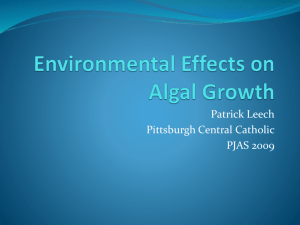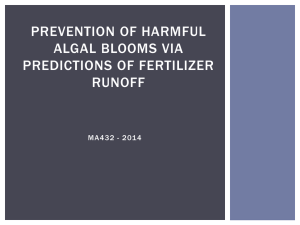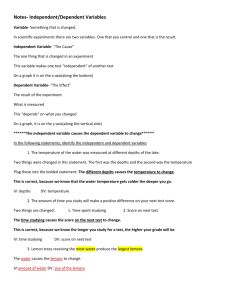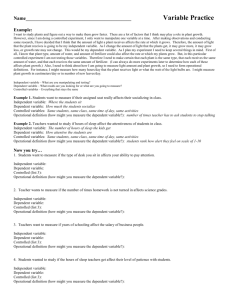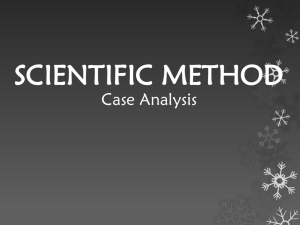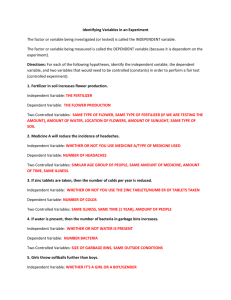Costello Effects of Nitrogen Eutrophication on Algae
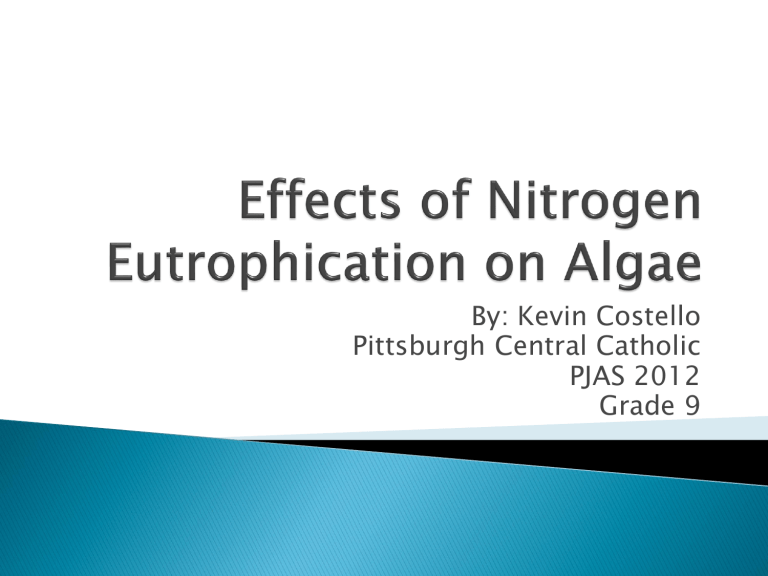
By: Kevin Costello
Pittsburgh Central Catholic
PJAS 2012
Grade 9
Occurs when large quantities of nutrients enter an aquatic environment. Nutrients often come from fertilizer.
Possible causes: sewage, agricultural runoff, or animal wastes
Algal bloom:
◦ Consisting of:
patches of algae near the surface of the water
Light attenuation
light dependent organisms stressed, massive die offs, increased
Large diverse group of simple and usually autotrophic organisms
Base of aquatic food chain
Used as a bio-indicator for aquatic environments
Generally cylindrical in shape with many flagella
Common algal like protist
A partial heterotroph can attain food through endocytosis and photosynthesis
Nutrient-rich freshwater or in sewage systems
Capable of survival in both salt and water environments
Frequently employed as an experimental model
Independently moving, unicellular, green, algae
Swims with its two flagella
Commonly found in fresh water and sometimes even in soil or in snow on mountain tops
Can grow on a simple medium of salts in the light, using photosynthesis to provide energy.
To discern the effect(s) of nitrogen based fertilizer on the survivorship of
Chlamydomonas reinhardtii and
Euglena
Null: The presence of fertilizer will
NOT have a significant effect on algal growth.
Alternative: The presence of the fertilizer WILL significantly alter algal growth.
Chlamydomonas reinhardtii
Euglena gracilis
Soil water (sterile)
Spring water
Miracle Grow® brand fertilizer
32 test tubes (13 x 100 mm borosilicate culture tubes)
Pipettes (macro + micro)
Pipette tips
Science Kit Educator spectrophotometer
Test tube rack
Desk lamp
1.
2.
A desk lamp was placed in experimental site a) approximately 45 centimeters away from the test tube racks b) Kept on a 12 hour on 12 hour off cycle c) Kept at 60 degrees °F throughout the duration of the study
Created a stock solution (assigned 100%) of fertilizer according to recommended application dose. Created the concentrations of 0%, 5%, 10%,
20% by mixing ingredients in borosilicate culture tubes as follows:
3.
Tubes were mixed by inversion daily and readings were taken using a spectrophotometer set to wavelength of 430 nm once a day on days 1-10
Algae
Soil Water
Spring Water 2mL
Fertilizer 0mL
Total 5mL
0%
2mL
1mL
5%
2mL
1mL
1.9mL
0.1mL
5mL
10%
2mL
1mL
1.5mL
0.5mL
5mL
1mL
1mL
5mL
20%
2mL
1mL
4,5
4
3,5
3
2,5
2
1,5
1
0,5
0
Day 1
Fertilizer Effects on Chlamydomonas
P Value: 9.04E-05
Day 3 Day 5 Day 7 Day 9
0%x
5%x
10%x
20%x
2,70
2,60
2,50
2,40
2,30
2,20
2,10
Fertilizer Effects on Euglena
P value: 1.44E-21
Day 1 Day 3 Day 5 Day 7 Day 9
0%x
5%x
10%x
20%x
Was the algae significantly affected by the presence of fertilizer in it’s environment?
◦ Chlamydomonas reinhardtii
P value: 9.04E-05
◦ Euglena gracilis
SIGNIFICANT
P value: 1.44E-21 SIGNIFICANT
Variable
Concentration
5% Miracle
Grow®
10% Miracle
Grow®
20% Miracle
Grow®
T Critical = 3.29
(significant)
Alpha = 0.05
T Value
8.61
10.92
13.49
Interpretation
Significant
Significant
Significant
Variable
Concentration
5% Miracle
Grow®
10% Miracle
Grow®
20% Miracle
Grow®
T Critical = 3.29
(significant)
Alpha = 0.05
T Value Interpretation
8.93
18.15
32.06
Significant
Significant
Significant
The ANOVA stat analysis allowed the null hypothesis to be REJECTED
The Dunnett’s test showed that all concentrations of fertilizer
SIGNIFICANTLY affected algal growth
Limitations
◦ Chlamydomonas reinhardtii and Euglena gracilis not fresh, 2 day travel time.
◦ Cultures not mono-culture
◦ Algal health and longevity might vary
Extensions
◦ Use more diverse groups of algae
◦ Use a higher concentration of the fertilizer
◦ Cell counts with hemacytometer
◦ Use different kinds fertilizer
Both organic and non-organic
Synergistic effects of agents?
http://www.encyclopedia.com/topic/eutrophi cation.aspx
http://www.amazingfacts.in/2010/06/amazi ng-facts-euglena.html
http://www2.mcdaniel.edu/Biology/botsyl01
/microalg/euglenaf/euglena.html
http://www.metamicrobe.com/chlamy/ http://www.chlamy.org/info.html


